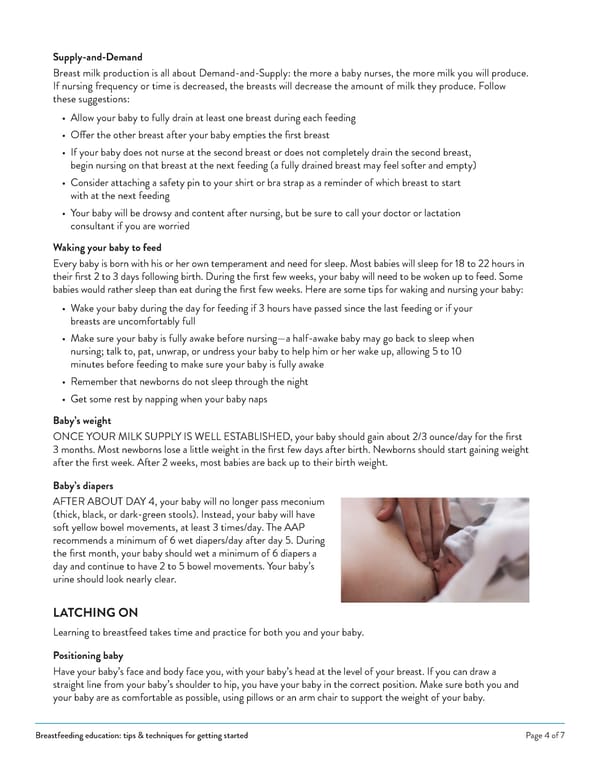Supply-and-Demand Breast milk production is all about Demand-and-Supply: the more a baby nurses, the more milk you will produce. If nursing frequency or time is decreased, the breasts will decrease the amount of milk they produce. Follow these suggestions: • Allow your baby to fully drain at least one breast during each feeding • Offer the other breast after your baby empties the first breast • If your baby does not nurse at the second breast or does not completely drain the second breast, begin nursing on that breast at the next feeding (a fully drained breast may feel softer and empty) • Consider attaching a safety pin to your shirt or bra strap as a reminder of which breast to start with at the next feeding • Your baby will be drowsy and content after nursing, but be sure to call your doctor or lactation consultant if you are worried Waking your baby to feed Every baby is born with his or her own temperament and need for sleep. Most babies will sleep for 18 to 22 hours in their first 2 to 3 days following birth. During the first few weeks, your baby will need to be woken up to feed. Some babies would rather sleep than eat during the first few weeks. Here are some tips for waking and nursing your baby: • Wake your baby during the day for feeding if 3 hours have passed since the last feeding or if your breasts are uncomfortably full • Make sure your baby is fully awake before nursing—a half-awake baby may go back to sleep when nursing; talk to, pat, unwrap, or undress your baby to help him or her wake up, allowing 5 to 10 minutes before feeding to make sure your baby is fully awake • Remember that newborns do not sleep through the night • Get some rest by napping when your baby naps Baby’s weight ONCE YOUR MILK SUPPLY IS WELL ESTABLISHED, your baby should gain about 2/3 ounce/day for the first 3 months. Most newborns lose a little weight in the first few days after birth. Newborns should start gaining weight after the first week. After 2 weeks, most babies are back up to their birth weight. Baby’s diapers AFTER ABOUT DAY 4, your baby will no longer pass meconium (thick, black, or dark-green stools). Instead, your baby will have soft yellow bowel movements, at least 3 times/day. The AAP recommends a minimum of 6 wet diapers/day after day 5. During the first month, your baby should wet a minimum of 6 diapers a day and continue to have 2 to 5 bowel movements. Your baby’s urine should look nearly clear. LATCHING ON Learning to breastfeed takes time and practice for both you and your baby. Positioning baby Have your baby’s face and body face you, with your baby’s head at the level of your breast. If you can draw a straight line from your baby’s shoulder to hip, you have your baby in the correct position. Make sure both you and your baby are as comfortable as possible, using pillows or an arm chair to support the weight of your baby. Breastfeeding education: tips & techniques for getting started Page 4 of 7
 Breastfeeding education: tips & techniques for getting started Page 3 Page 5
Breastfeeding education: tips & techniques for getting started Page 3 Page 5